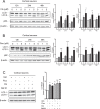The tricyclic antidepressant clomipramine inhibits neuronal autophagic flux
- PMID: 30890728
- PMCID: PMC6424961
- DOI: 10.1038/s41598-019-40887-x
The tricyclic antidepressant clomipramine inhibits neuronal autophagic flux
Abstract
Antidepressants are commonly prescribed psychotropic substances for the symptomatic treatment of mood disorders. Their primary mechanism of action is the modulation of neurotransmission and the consequent accumulation of monoamines, such as serotonin and noradrenaline. However, antidepressants have additional molecular targets that, through multiple signaling cascades, may ultimately alter essential cellular processes. In this regard, it was previously demonstrated that clomipramine, a widely used FDA-approved tricyclic antidepressant, interferes with the autophagic flux and severely compromises the viability of tumorigenic cells upon cytotoxic stress. Consistent with this line of evidence, we report here that clomipramine undermines autophagosome formation and cargo degradation in primary dissociated neurons. A similar pattern was observed in the frontal cortex and liver of treated mice, as well as in the nematode Caenorhabditis elegans exposed to clomipramine. Together, our findings indicate that clomipramine may negatively regulate the autophagic flux in various tissues, with potential metabolic and functional implications for the homeostatic maintenance of differentiated cells.
Conflict of interest statement
The authors declare no competing interests.
Figures



Similar articles
-
Intracellular calcium signaling systems in the pathophysiology of affective disorders.Life Sci. 1998;62(17-18):1665-70. doi: 10.1016/s0024-3205(98)00125-8. Life Sci. 1998. PMID: 9585154 Review.
-
Effects of clomipramine and other tricyclic antidepressants on biogenic amine uptake and turnover.Postgrad Med J. 1976;52(3 suppl):33-9. Postgrad Med J. 1976. PMID: 785423 Review. No abstract available.
-
Antidepressants and serotonin neurons of the raphe.Neuropsychobiology. 1981;7(3):113-21. doi: 10.1159/000117840. Neuropsychobiology. 1981. PMID: 6785659
-
The antidepressant clomipramine regulates cortisol intracellular concentrations and glucocorticoid receptor expression in fibroblasts and rat primary neurones.Neuropsychopharmacology. 2003 Sep;28(9):1553-61. doi: 10.1038/sj.npp.1300195. Epub 2003 May 7. Neuropsychopharmacology. 2003. PMID: 12784111
-
Antinociceptive effect of clomipramine through interaction with serotonin 5-HT2 and 5-HT3 receptor subtypes.Folia Med (Plovdiv). 2012 Oct-Dec;54(4):69-77. doi: 10.2478/v10153-012-0008-2. Folia Med (Plovdiv). 2012. PMID: 23441472
Cited by
-
Selective elimination of host cells harboring replication-competent human immunodeficiency virus reservoirs: a promising therapeutic strategy for HIV cure.Chin Med J (Engl). 2021 Oct 7;134(23):2776-2787. doi: 10.1097/CM9.0000000000001797. Chin Med J (Engl). 2021. PMID: 34620750 Free PMC article.
-
The Antidepressant Drug Amitriptyline Affects Human SH-SY5Y Neuroblastoma Cell Proliferation and Modulates Autophagy.Int J Mol Sci. 2024 Sep 27;25(19):10415. doi: 10.3390/ijms251910415. Int J Mol Sci. 2024. PMID: 39408742 Free PMC article.
-
FDA-approved drugs containing dimethylamine pharmacophore: a review of the last 50 years.RSC Adv. 2024 Sep 2;14(38):27657-27696. doi: 10.1039/d4ra04730c. eCollection 2024 Aug 29. RSC Adv. 2024. PMID: 39224646 Free PMC article. Review.
-
Inhibiting Leishmania donovani Sterol Methyltransferase to Identify Lead Compounds Using Molecular Modelling.Pharmaceuticals (Basel). 2023 Feb 21;16(3):330. doi: 10.3390/ph16030330. Pharmaceuticals (Basel). 2023. PMID: 36986430 Free PMC article.
-
Enriched environment boosts the post-stroke recovery of neurological function by promoting autophagy.Neural Regen Res. 2021 May;16(5):813-819. doi: 10.4103/1673-5374.297084. Neural Regen Res. 2021. PMID: 33229714 Free PMC article.
References
Publication types
MeSH terms
Substances
Grants and funding
LinkOut - more resources
Full Text Sources
Other Literature Sources

